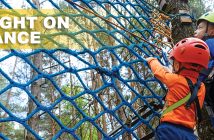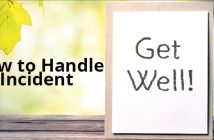A surprising number—35 percent—of all incidents related to the aerial adventure industry occur off the course. We often focus on the safety and risk management of the zip line or aerial adventure park itself: proper rescue procedures, reducing the amount of collisions into trees and platforms, etc. However, far too often we neglect to address all the risks surrounding the guests’ visit. These areas of risk management are just as important to address as the actual safety of the course.
Let’s explore some practices that can be implemented for your operation. We will review these points of risk in the order that participants are usually exposed to them.
Websites
The customer experience begins online, before anyone steps foot on your facility. Your website is your first opportunity to establish the safety and risk management “tone” for your operation. Make the most of this! Show customers that you truly care about their safety and educate them throughout the user experience on your website.
Does your site have photos of participants in sit harnesses going upside down on the zip line? Are participant requirements and expectations clearly stated? How easy is it to find out what I need to bring and what I should/shouldn’t wear? Make sure your online presentation of safety and risk management practices is consistent with what visitors will find at your physical location.
Parking Lot
As soon as participants pull into the parking lot, the adventure begins. Kids are piling out of the car, excited about what they’re about to experience. At that moment, they’re not thinking about safety. With this in mind, here are some things to consider for parking lots:
1. Make sure your parking lot is clearly defined and organized so participants know where to park. An open field with no organized parking pattern is confusing, and can lead to hazards.
2. Do your tire blocks and landscaping materials create hazards? For example, if you use round logs as tire blocks or landscaping edges, secure them to the ground. That way, if a guest stands on one, the log can’t roll over and cause him or her to break an ankle. This incident has happened.
3. Are there clear directions, signs, and pathways pointing where to go, or do the participants have to wander around to find the proper place? Good wayfinding creates a predictable pattern of pedestrian traffic.
Check-In Building
This is the single most influential time you have to capture participants’ attention and educate them about the experience, and the risks involved. Some important considerations include:
Signage: Conspicuous locations and clear messages.
Customer interaction: Be engaging. Be friendly. Be caring. Be informative.
Weighing in: Weighing all participants is a must in today’s aerial adventure world. Use a digital scale that reads behind the check-in counter, so only the employee can see the weight. Staff can give thumbs up or thumbs down, and have a side conversation with participants who are above the weight limit. You may also want to record the weight in a section on your waiver.
Waivers: What are your procedures to ensure that everyone has signed a waiver? What are your procedures to ensure that the correct person signed the waiver? Remember, a waiver is only enforceable if a parent or legal guardian signs it. Only a court can grant legal guardianship to someone. This is something you should have on your website so people know in advance. A simple statement saying, “All waivers must be signed by a parent. No exceptions” is preferable.
ATVs and Vans
We have seen some significant accidents involving ATVs and van usage. Anyone using an ATV or van should be required to go through a training program for vehicles. This can be done in-house and does not need to be fancy, but not just anyone should be allowed to operate a vehicle. Have an approved list of drivers who are more than 25 years old with acceptable motor vehicle records (checked yearly), and who have passed your annual ATV/van training. The ATVs and vans should have a maximum speed (ATVs kept in low gear at all times) that all drivers abide by.
Premises and Nature Trails
Nature trails and/or the trails between platforms can be the biggest risk a course has. Nature trails are often on steep terrain, and if these are unguided and something happens to the participant, response could be delayed, which could greatly impact the injury. Make sure all the steps, rocks, and walkways on the nature trails are as free from undergrowth, moss, and slippery substances as possible. While it is an outdoor environment, and these elements are natural, the more you can do to reduce or prevent these hazards, the better.
Contractual and Lease Agreements
We could spend a whole day on contractual risk transfer, which includes contracts with builders and inspectors, as well as lease agreements. Contracts are documents used to transfer risk to another party. So the question is: what risk(s) is/are being transferred to you through this document? Can your insurance program(s) handle the risk being transferred to you? These are all great questions to ask your insurance consultant and legal counsel. Always read and understand each contract you are signing.
There are three main things a lot of contracts either ask you to do, or you should be asking the other party to do:
1. Additional Insured: When you add someone as additional insured to your general liability policy, that means you are now sharing your limits of insurance with someone else. If you have $1 million of liability coverage, you are now splitting that $1 million of coverage between two parties. Just think how many additional insureds you add in a year, and the number of parties you could be sharing your liability limits with.
2. Primary and Non-Contributory: This is an endorsement that can be added to the general liability policy that essentially says: “Whichever party is adding this to its GL policy is stating that its liability policy is primary (will respond first), and that the general liability policy of the organization that is requesting this will not contribute in any way, shape, or form.”
3. Waiver of Subrogation: Let’s say you are an operator and an employee gets injured on the course. After workers’ compensation pays for the claim, the company finds out the employee was injured because the builder goofed on the build. So essentially the employee injury was the builder’s fault. In this scenario, your workers’ compensation company would sue the builder to collect for the amount it paid for the employee injury claim. This process is called subrogation.
When you add a waiver of subrogation to your policy (auto, general liability, or workers’ compensation) you are legally waiving your insurance company’s right to “subrogate,” or recoup, its claim payments from the responsible party. Keep in mind, if you did not add this provision to your policy, the carrier can re-collect from the responsible party and it will not show up on your loss history. Which, in effect, will keep your premiums lower. Adding the waiver of subrogation endorsement could eliminate an avenue to clear a loss from your record, if it was in fact someone else’s fault.
Here is a general rule of thumb: if you are adding any of the above three provisions to your policy, you are accepting more liability. If you are able to get these added to someone else’s policy (builder, property owner, etc.) then you are pushing away more liability. It all comes down to who has the greater negotiating power.
These are just some examples of off-course safety and risk management issues to consider. If you have any questions, contact your insurance consultant.






